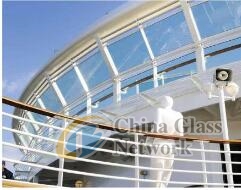Post Time:Aug 28,2017Classify:Industry NewsView:1062
Trosifol engineers recently commissioned rigorous salt spray testing of a variety of laminated glass samples at a TÜV SÜD laboratory in Singapore.
Salt spray testing is harsh but necessary, in order to reinforce peace of mind regarding an interlayer’s capabilities. This testing is all the more important when it comes to applications in salt-laden costal regions or on the water. As a result of a recent comprehensive and demanding independent test series, Trosifol recommends – depending on the scope of application – Trosifol® UltraClear High Adhesion or SentryGlas®.

The adoption of laminated glass as a structural material in architecture is growing almost exponentially, as architects, designers and engineers begin to appreciate the added potential offered by modern interlayers.
Traditionally adopted for their aesthetics, materials such as Trosifol PVBs and SentryGlas® ionoplast interlayers, have significantly expanded the applications for glass, especially where minimal support is deployed or post-breakage safety is a concern.
However, with this expanded uptake in newer, more demanding applications, additional testing has to take place to create the peace of mind that architectural glazed panels can endure the same environmental conditions as the structural elements surrounding or supporting them. It therefore makes sense that if the metal components are subject to rigorous testing then the glazed elements should be, too.
One avenue of testing is measuring the adverse effect of environmental conditions, especially in salt-laden coastal applications, with salt spray testing being one of the most widespread and long established corrosion tests. ASTM B117 Standard Practice for Operating Salt Spray (Fog) Apparatus was the first internationally recognized salt spray standard, originally published in 1939. Other standards include the American Architectural Manufacturers Association standard AAMA 2604-05 or the British Centre for Window and Cladding Technology CWCT-Guidelines.
If we were to apply this test to glass on its own, we would not see any adverse effects; with glass being a relatively inert material. However, this may not be the case for the interlayers, especially if they are deployed in open-edge laminated panels.
Rajan Govind, Director of BES Façade Consultants, India, has a very strong argument to this regard: “When we talk about glass railings as a complete system in a balcony, it’s not only the metal but glass as well – both are subjected to exactly same conditions. If the glass panel develops any visual defects in such applications, it would be an awful experience for the owner of luxurious condominiums in Mumbai, or, indeed, anywhere else. So, why should glass not be tested too?”
With this in mind, and as part of its ongoing product development activities, engineers at Trosifol recently commissioned rigorous salt spray testing of a variety of laminated glass samples at a TÜV SÜD laboratory in Singapore. Additional testing has also taken place at Trosifol’s laboratory in Troisdorf, Germany.
As a result of these testing regimens, Trosifol recommends its Trosifol® UltraClear High Adhesion PVB interlayer and its SentryGlas® interlayers for laminated glass applications with edges exposed to the environment, due to their high edge stability.
Christoph Troska, Manager Global Architecture Segment, explains: “These tests may be a little harsh for laminates, but it is vital to ensure that they can perform in the same conditions as the framework around them – delivering the same structural and aesthetic capabilities for which they were originally specified. Constant testing and product development is normal at Trosifol, as it continues to seek and offer its customers even more peace of mind when it comes to choosing and applying the world’s leading PVB and ionoplast interlayers.”
The results of the tests and further explanations are summarized in the document ‘Trosifol Salt Spray Testing’, which is available for download from www.trosifol.de. Both Trosifol® UltraClear High Adhesion and SentryGlas® interlayers performed admirably. Other Trosifol films show the same results as commercially available films.
Source: www.glassonline.comAuthor: shangyi